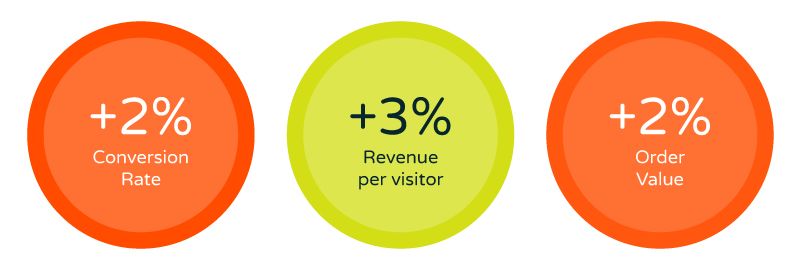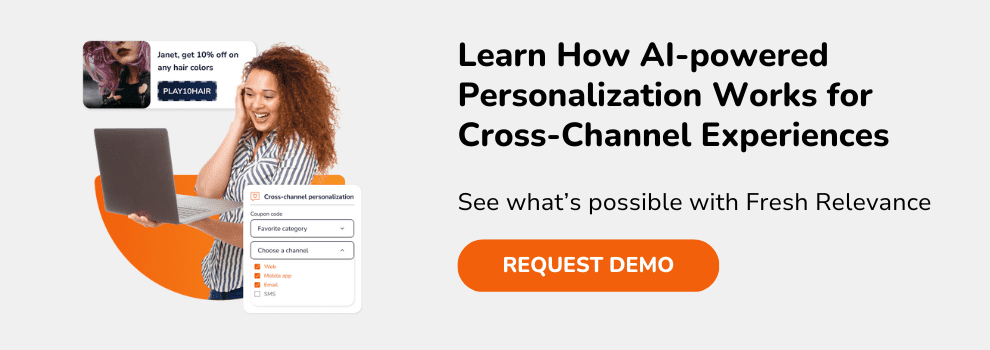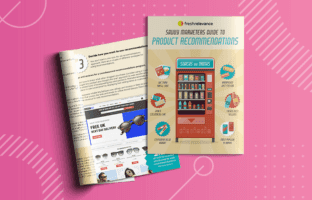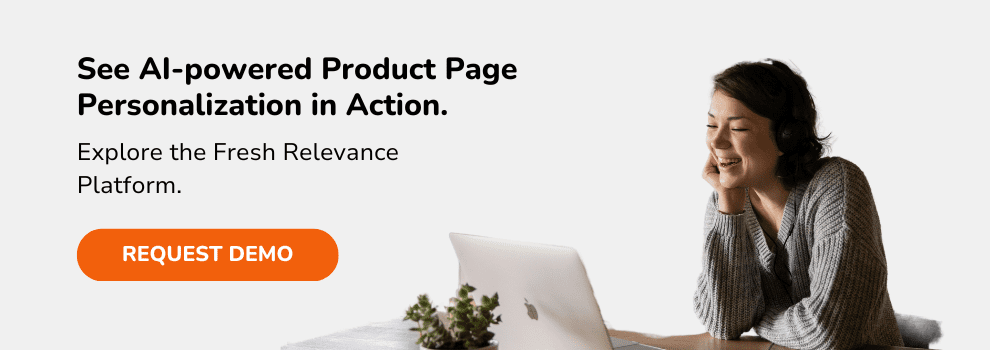learning path
The Complete Guide to Personalized Product Recommendations

Have you ever tried on clothes in a store and had a sales clerk bring over a top they recommend to go with the jeans you’re considering? Or you are about to check out at a kitchenware store when the clerk recommends a cleaning product that will help you keep the cutting board you are purchasing looking new?
These clerks were trained to help close the sale and increase the average order value with product recommendations. It’s a tactic as old as retail itself.
What are product recommendations?
In the eCommerce world, product recommendation engines use machine learning to select items to be displayed in a specific marketing channel (such as email) or across the organization (web, email and social).
Product recommendations are proven to be a successful eCommerce tactic. Our customers tell us they see, on average, the following uplift from using recommendations:

Do all product recommendation engines deliver personalized recommendations?
The short answer: No.
Some recommendation engines only offer non-personalized recommendations through a variety of data and techniques such as collaborative filtering techniques, social proof, and business rules. Here’s how each works:
Crowdsourced recommendations
Shoppers who looked at those salad bowls looked at these tongs.
Social proof
Top-rated items, best sellers and trending products are displayed in the category viewed.
Business rules
Marketers elect to show items from a category such as top-selling items, items on sale, items in low supply or complementary products.
How are personalized product recommendations different?
A personalized recommendation engine queues up product recommendations that are unique for every viewer or subscriber.
The engine uses the customer’s buying and browsing history to create a profile that leads to recommendations specific to that customer. If a shopper clicks on turtlenecks, the recommendation engine will show turtlenecks that haven’t been viewed yet. It might also show similar brands (to those viewed) or similar categories.
If a customer has recently purchased furniture in a specific style, they would see furniture similar to that when they shop online, or a promotional email would include recommendations that match their recent purchase.
Personalized product recommendations can also include location-based triggers – such as pulling in a real-time weather forecast into emails and website content and queuing up products that make sense for the weather forecast in the customer’s geographic location.
Can one product recommendations engine work across email and the online store?
Some recommendation engines only work for one channel. That means more work for the marketer. Setting up separate programs for email and your eCommerce site is time-consuming, especially if A/B testing and sign-offs from stakeholders are required.
Having one recommendation engine that sits on top of the different channels and delivers the appropriate content to each channel is a more logical choice.
An omnichannel approach is particularly important for personalized recommendations. If a shopper has been clicking on certain clothing items but abandons the browsing session, you might send a browse abandonment email showing other choices in that category. But not everyone opens the browse abandonment email. If the shopper returns to your site, you’ll want to make sure the product feed reflects what they were interested in earlier.
How can I measure the success of a product recommendations engine?
Unlike a cart abandonment email program, measuring the success of product recommendations isn’t quite as simple as tallying the conversions from the campaign.
Here are some of the metrics that should improve after implementing a product recommendations program:
Changes in website browsing time
A product feed on the homepage should be engaging the customer more than a generic one. But it might not increase browsing time. Instead, browsing time can go down in relation to conversions. Shoppers are finding what they are looking for more quickly.
Higher click-throughs on email campaigns
Promotional and triggered campaigns (cart and browse abandonment) should be more engaging with recommendations.
Higher click rates on your website
If the product feed is personalized that should increase click rates as customers view what you’ve suggested for them.
Higher open rates for emails
Category information can be pulled into subject lines enticing shoppers to open the emails where the more specific recommendations are offered.
Increased average order value
If your recommendations are designed to encourage customers to buy products that go with the ones they are browsing or carting, this metric should increase.
Sales uplift
Whether from the email program or the overall eCommerce sales, a sales uplift if the best metric.
How are brands using product recommendations?
Many large brands use some type of product recommendation as part of their online retail programs. It’s companies like Amazon, after all, that helped shape the success of eCommerce by pioneering product recommendations.
But the technique isn’t exclusive to large brands. Plenty of small to mid-size online retailers have successfully deployed product recommendations to increase sales.
Recommendations across channels
MyOptique Group incorporates personalized product recommendations on its website and in triggered and campaign emails. It’s Glasses Direct division attributes 1.2% of online revenue to web recommendations.
Recommendations in abandonment email
Orlebar Brown, a London-based fashion retailer, incorporated product recommendations into its cart abandonment emails. The move contributed to a 6.59% sales uplift. It also added recommendations to in-parcel marketing information sent with its items which adds a delightful bespoke touch.
Recommendations in email newsletters
Buyagift, the UK’s leading provider of experience days, has seen a 24% sales uplift since including personalized product recommendations in their email newsletters
Subject lines that engage
Wolseley, a leading supplier of building materials, has increased its average open rate from 28% to 45% using automated product recommendations fed into subject lines.
Personalizing the home page
Global surfing brand Rip Curl saw sales increase 1.8% after adding personalized recommendations to its home page. The success has encouraged the company to roll out personalized recommendations to its product pages.
Personalizing product pages
Cooksongold, the UK’s largest one-stop shop for the jewellery maker with over 19,000 products, saw a 112% sales increase since implementing onsite product recommendations. The retailer highlights recently browsed items on product pages, enabling them to present products likely to be of specific interest to the customer.
Social proof + recommendations drive click-throughs
Pet product specialist VioVet incorporated its in-house star rating system into all of its recommendations (and cart and browse abandonment emails). This has resulted in a 19% increase in click-throughs.
What should I look for in a product recommendation solution?
The popularity of product recommendations as a marketing tool has led to a lot of vague marketing boasts. At its heart, a good product recommendations solution is backed by solid machine learning and is easy for the marketer to use.
Here are some other features to look for in a solution.
Robust collaborative filtering
There are many different options for non-personalized recommendations. Make sure your engine includes a wide variety including options like “Frequently bought with this” and “After viewing this, people buy”.
Personalization
Some product recommendation solutions incorporate machine learning, but it’s only used to deliver collaborative filtering recommendations. Personalized recommendations use customer browsing, buying behavior and purchase history.
The option to blend recommendation types
Sometimes you want to give customers recommendations based on what other customers bought – but with a twist. When you have access to both personalized and crowdsourced recommendations, you can set up both to provide variety and maximize the conversion potential.
A cross-channel rules engine
Recommendations work best when they are woven into different channels seamlessly. Solutions that only work for email or the web limit that option.
Real-time recommendations
To use recommendations in cart abandonment emails (which should be sent out within an hour), you need an engine that can pull the information quickly.
Ease of use
Recommendation programs that are difficult to launch or involve complex integration steps will make it more difficult for marketers to use effectively. You’ll also want the option of reusing templates.
How Fresh Relevance can help you optimize your product recommendations
Fresh Relevance’s product recommendation technology helps you align your recommendations strategy with the shopper’s stage in the purchase journey or customer lifecycle. Our product recommendations engine combines real-time data with sophisticated merchandising rules and powerful machine learning to display the most relevant recommendations to each shopper.
Learn more about Fresh Relevance’s product recommendations tool and read the articles below to discover a few ways you can boost average order value with product recommendations.
A final word on product recommendations
Cart and browse abandonment strategies have been gaining ground, consistently showing returns for several years. Recommendations are the next logical step as machine learning drives more options and features every year.
Yet, marketers are sometimes hesitant to add recommendations to their toolbox because they think setting up a recommendations program is too time-consuming.
Our clients tell us that once they take the plunge, those fears are allayed.
A recommendations program can start simple – with recommendations going into an abandoned cart email, and gradually building out from there. It is a marketing tactic that not only increases revenue but also helps to establish that one-to-one relationship that customers say they want.
Find out more about our industry-leading Product Recommendations solution.
FAQs
What are the benefits of personalized product recommendations?
With personalized product recommendations, you’ll see higher click-through and open rates on emails, higher click-throughs on the website, increased average order value (AOV), and an uplift in sales — all because shoppers can find what they are looking for more quickly.
What is a non-personalized product recommendation?
A non-personalized recommendation that does not rely on a shopper’s preferences, behavior, or individual characteristics. It is based on a general trend or broad category and delivered to a wide audience. Examples include bestsellers, new arrivals, or items at a particular price point. Non-personalized recommendations can help introduce shoppers to new or popular items.
What is the impact of product recommendations on sales?
Product recommendations increase conversion rates, AOV, and customer engagement, while reducing cart abandonment. They contribute to a more tailored and enjoyable shopping experience for your customers, ultimately leading to higher revenue and improved customer retention. Product recommendations can generate sales uplifts of up to 11%.








